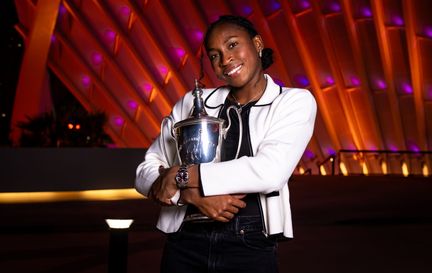WIMBLEDON -- One set into her first ever Wimbledon main draw match on Monday, Diana Shnaider was struggling. The 20-year-old had just won the biggest title of her career to date at the Bad Homburg WTA 500, but that had meant just two days to travel and adjust to the lawns of SW19. She had been handed a tough draw, too, in the form of 2021 finalist Karolina Pliskova.
Wimbledon 2024: Scores | Draws | Order of play
And there was something else that threw her off. Shnaider was playing bare-headed, without her signature headscarf, and she found the sensation "weird and uncomfortable." (A year ago in qualifying, Shnaider explained that she had been unable to source a headscarf in high-quality white material for Wimbledon, and her search is ongoing.)
"I felt like I left all the emotions in Bad Homburg," Shnaider said after defeating Pliskova. "It wasn't hard physically, it was harder mentally. I couldn't get the positive energy on court to get pumped. But I thought, OK, it's just 6-4. It's one break. It's pretty close. No matter how, I just need to win second set, take it to the third, and maybe I will feel more relaxed. Then I won second set and thought, OK, keep rolling it."
Shnaider certainly did keep rolling it. She emerged a 4-6, 6-4, 7-5 victor; her third set was highlighted by a spectacular hold from 0-40 at 4-4, full of blazing winners, and then the composure to hold firm after Pliskova saved a pair of match points with service winners in the next game.
"If I don't go for it, she will go for it," Shnaider explained about her all-out aggression with her back to the wall. Her reward is another tough draw, former US Open champion Sloane Stephens, with a spot in the third round of a major for the first time at stake. (Ed. note: following the publication of this interview, Shnaider defeated Stephens 6-1, 6-1 to extend her winning streak to seven.)
The left-handed Shnaider's powerful hitting is thrilling to watch; the easy pace she can find on the ball frequently draws gasps. But it's also the rapidity of her improvement that makes her such an exciting prospect, and a dark horse in the wide-open bottom half of the Wimbledon draw. In her first professional grass-court tournament, she lost to No.370-ranked British wild card Anna Brogan in Wimbledon qualifying last year. In her second, she fell to Yuan Yue in the first round of 's-Hertogenbosch three weeks ago.
Then she reached the Birmingham quarterfinals, and began to find her footing. One week later, she defeated a slew of grass-courters including Angelique Kerber and Donna Vekic to win Bad Homburg, the second tour-level title of her career (following Hua Hin in February). This year's Wimbledon is just the fifth grass-court tournament of her career; she's now on a six-match winning streak and at a career-high ranking of No.30.
"Very nice few weeks on the grass," Shnaider said with satisfaction. "When you play more matches it helps."
Every player would agree that experience on grass is crucial, but the learning curve from getting out-manoeuvred by lowly-ranked British wild cards to overpowering former Wimbledon champions usually takes years, not a mere four tournaments.
More from Wimbledon:
- Grass-court Power Rankings: Who thrives on the turf?
- The feel-good stories of the grass season so far
- Is grass-court tennis the trickest surface on the tour?
- Familiar faces: Barty, Sharapova return to Wimbledon with their sons
- Gauff, Osaka, Raducanu? Who will come through the wide-open bottom half?
- Raducanu taking inspiration from England's run at the Euros
The most significant change Shnaider has made in the past month is to her team. Just over a year ago, she was still playing college tennis at North Carolina State; when she went pro, she began searching for a full-time coach. Shnaider trialled a few potential names, but didn't find a relationship that stuck -- until, maybe, now. At the start of the grass swing, she began working with former ATP Top 20 player Igor Andreev.
"At first I thought it was the wrong time to start," Shnaider said. "Grass is very unpredictable, and how can he get me ready for that? But we fit each other on and off the court, and I hope we will stick together for a while. [His coaching style] is very simple -- but at the same time, when someone can explain hard things in simple words, it's really great. On grass, for example, he tells me to stay low. And if you see a short ball, move to it faster because it will stop and not bounce at all.
So far, this approach has paid dividends in harnessing Shnaider's formidable weapons. Last week in Bad Homburg, both her power and her willingness to finish points at net felt like a glimpse into a future grass-court force. All she needs now is a good white fabric: London tailors, opportunity is knocking.



![[3] Coco Gauff d. [7] Zheng Qinwen 3-6, 6-4, 7-6(2), WTA Finals Riyadh F (3:04). Gauff clinched her first WTA Finals title by winning the second-longest final of the year. It was also the longest final at the WTA Finals dating back to 2008.](https://photoresources.wtatennis.com/photo-resources/2024/11/09/4a2a1712-283c-4996-a572-6682f3eeca0c/GettyImages-2183155727.jpg?width=451&height=268)



